france
-
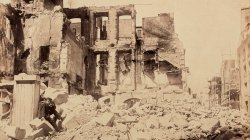
The ruins of the Commune, rue du Bac
The ruins of the Commune, rue du Bac. Before 1870(?).- KorbenDallas
- Media item
- france paris
- Comments: 1
- Category: The Paris Commune 1870-1871
-
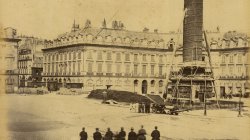
Vendôme Column and Felling Machinery #3
Place Vendôme; General Staff Officers Supervising Felling Arrangements of the Column in 1871.- KorbenDallas
- Media item
- 1871 france vendôme column
- Comments: 0
- Category: The Paris Commune 1870-1871
-
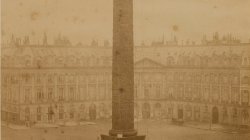
Installation of the statue of Napoleon I on the Vendôme column, 1875
The scaffolding is mounted on top of the column for the assembly of the statue. The workers and foremen pose on the scaffolding on which is fixed the sign "E DUPREZ / carpenter". Ropes hang from the top of the column. Another sign is fixed at the bottom of the column, near a ladder: "E. DUPREZ /...- KorbenDallas
- Media item
- 1875 france napoleon vendôme column
- Comments: 0
- Category: Paris after 1870-71 Commune Events
-
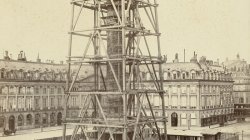
Reconstruction of the Vendôme Column in 1873
Following the suppression of the Commune, the Vendôme Column was rebuilt in 1873.- KorbenDallas
- Media item
- 1873 france vendôme column
- Comments: 0
- Category: Paris after 1870-71 Commune Events
-
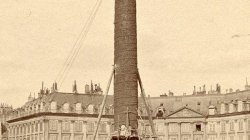
Vendôme Column and Felling Machinery #2
This scene shows cables tied o the column to be used to pull down the Column of the Grand Army on May 16th 1871 by the Communards.- KorbenDallas
- Media item
- 1871 france vendôme column
- Comments: 0
- Category: The Paris Commune 1870-1871
-
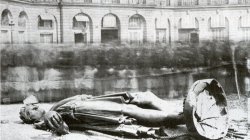
Dismantled Statue of Napoleon in Paris, 1871
A statue of Napoleon lies broken in the Place Vendome after being dismantled by the Paris Commune. The Commune described the statue as "a monument of barbarism, a symbol of brute force and false glory".- KorbenDallas
- Media item
- 1871 france paris
- Comments: 0
- Category: The Paris Commune 1870-1871
-

52 BC Battle of Alesia: where and when did it happen?
52 BC Per the narrative, the Battle of Alesia or Siege of Alesia was a military engagement in the Gallic Wars around Alesia in modern France. It was fought by the Roman army of Julius Caesar against a confederation of Gallic tribes united under the leadership of Vercingetorix of the Arverni. It...- KorbenDallas
- Article
- 52 bc alesia alexia arverni battle caesar france vercingetorix war
- Replies: 4
- Section: Wars and Conflicts
-

1798: Napoleon's Windmill powered Floating Fortress
While learning new things about Napoleon, I came across this floating contraption. I guess, some prisoner claimed that such a thing was in the works. Considering that it was supposed to be made of wood (pictures suggest that), the entire idea looks uber bizarre (unless it was supposed to be...- KorbenDallas
- Article
- england france ship windmill
- Replies: 9
- Section: Ships
-

1864: Construction of the Palais Garnier and Cannons
We have a good enough quality of an image (1864 allegedly) to allow for some scrutinizing. Below is the construction site of the future Palais Garnier. Make sure you checkout this beauty, especially inside. The photograph is taken in the direction of the north, towards the stage and the...- KorbenDallas
- Article
- france opera paris
- Replies: 1
- Section: Theaters and Operas
-

1580: Château de Lesdiguières. Now and Then.
To be honest, I am not even sure that this is the same structure. It appears to be the same. Both are located in the vicinity of Grenoble, France, and both are called "Château de Lesdiguières." Now + TPTB History The Château de Lesdiguières is located on the territory of the French commune of...- KorbenDallas
- Article
- castle france
- Replies: 1
- Section: Castles
-

1812 Battle of Borodino: Napoleon's Army and Battle Evidence
The Battle of Borodino was a battle fought on 7 September 1812 in the Napoleonic Wars during the French invasion of Russia. The fighting involved around 250,000 troops and left at least 70,000 casualties, making Borodino the deadliest day of the Napoleonic Wars. I find it interesting that in...- KorbenDallas
- Article
- borodino france napoleon russia war
- Replies: 0
- Section: Wars and Conflicts
-

1799: Destruction of the English Fleet
1799 is when the image was published, that is my understanding. Anyways, the Google Translated description to the image sounds like this. Fire of the English fleet: the English fleet burned down by the Greek fire and that of the new floating towers, armed with mouths to protect on the coasts...- KorbenDallas
- Article
- england fleet france war
- Replies: 0
- Section: Wars and Conflicts
-

16th century Paris: Size vs. Population
In our today's world Manila leads the way in population density with 107,561 people per square mile. I was looking for something unrelated and came up on the population of the city of Paris in the 16th century. Wikipedia states: Paris was the largest city in Europe, with a population of about...- KorbenDallas
- Article
- france manila paris philippines
- Replies: 0
- Section: World Population
-

1793: Marie Antoinette and Elongated Skulls
Normally, intentionally elongated or flattened skulls are associated with ancient Mesoamerican cultures. But this exquisite specimen, which dates back some 1,500 years, was recently found at a dig in Alsace, France. French archaeologists made a surprising discovery during an excavation, when...- KorbenDallas
- Article
- france skull
- Replies: 11
- Section: World-Historical Individuals
-

1870: Franco-Prussian War. Missing Combat Photographs.
Here is another 19th century photographic absentee. How historians were getting away with things like this is hard to understand. May be scrutinizing the absence of the photographic evidence was not really a thing, but I have hard time believing that we are the first ones to notice the lack of...- KorbenDallas
- Article
- france paris photography war
- Replies: 0
- Section: Missing Photographs
-

1877: The Hemi-Plunger Ship by Monsieur Donato Tomassi
Ran into this 1877 ship designed by a certain M. Donato Tomassi. It does not sound like this ship was ever made, but then again, do we really know? Here is a short description of this 19th century wonder. The Hemi-Plunger The novel form of vessel, to which the above odd name has been given by...- KorbenDallas
- Article
- france ship tommasi
- Replies: 0
- Section: Ships
-

1876: French Ironclad Redoutable - another example of Tartarian technology?
This is a build up on my other related articles: 1854-59 ship: SS Great Eastern a.k.a. Leviathan Our civilization did not build Titanic, Olympic or Britannic. Theirs did. Was it the Tartarian one? The idea behind these series of articles is that if we can not explain what technology was used...- KorbenDallas
- Article
- france ironclad redoutable ship war
- Replies: 0
- Section: Ships

